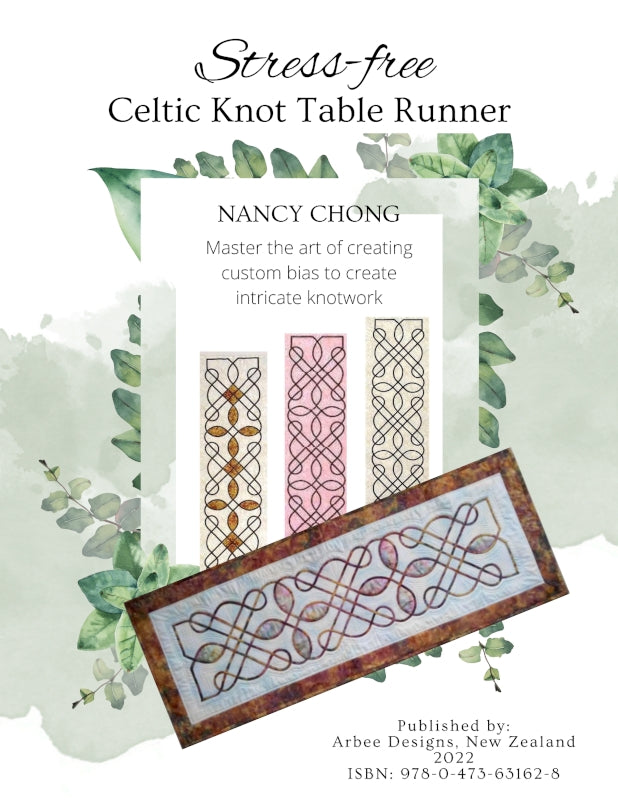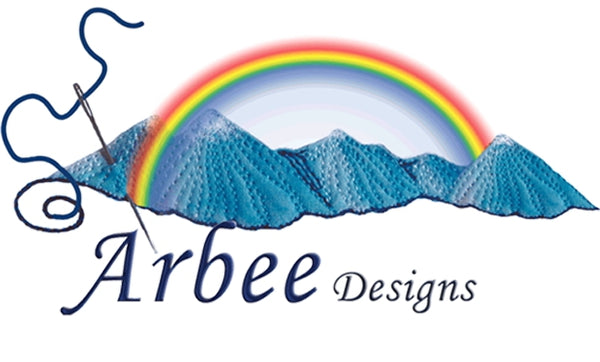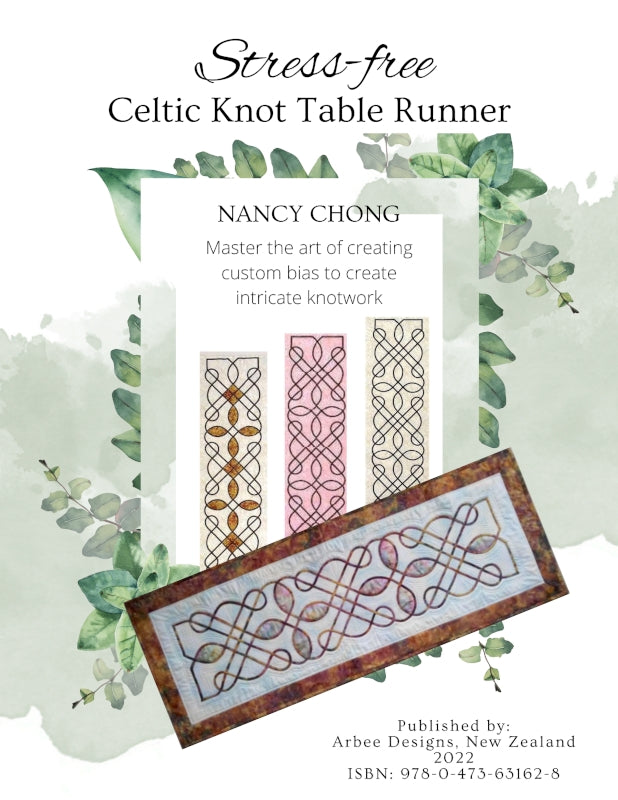
- Description
- Requirements
Celtic knotwork designs are captivating because of their intricacy and symmetry. Do not let that frighten you away. Now you can learn Nancy's stress-free methods and discover how easy it is to make this table runner.
You will learn about marking fabrics (whether light or dark); learn a new, easier and quicker way to make bias tape; learn a wonderfully easy method to hand appliqué the Celtic bias strips in place; and explore options for inserting fabric, stained-glass-style, to create your own unique table runner.
Master the technique in this small project and you will be able to use it in other quilting projects. This ebook is suitable for beginners, but experienced appliquérs will learn new skills too.
OUTLINE
Part One
- Marking design on background fabric
- Learning about various marking tools
- Light box method
- Pattern transfer paper method
- Making Celtic bias tape using Clover 1/4" Bias Tape Maker
Part Two
- Learning basic appliqué stitch
- Techniques and helpful hints for placing bias tape into position
- Inserting fabric stained-glass-style
Part Three
- Exploring quilting and embellishment options
- Adding the binding
Supplies
FABRIC

left: Speckled; middle: Mottled; right: Striped
Bias Tape
1 yard of ATTENTION-GETTING FABRIC. (1/2 yard will be used for the Celtic bias strips, and 1/2 yard for the binding.) 100% cotton fabric works best.
In Part One, I will teach you a wonderfully fast, easy, and inexpensive way to make your own bias tape. If you wish to use your own fabric for this method, the sky is the limit for your fabric choices. Each fabric will behave a little differently, depending on its stiffness, thread count and general fabric thickness. I work with all types of cotton fabrics suitable for quilts, but I particularly love to work with the finely-woven cotton batiks that are readily available to quilters.
Have fun with this choice; be as wild and crazy or as polite and subdued as you want. Choosing the right bias tape can be an adventure. You will be surprised at how different a fabric will appear once you have made the bias tape. Here are three fabric choices, and see how different they appear once the bias tape is made.
Background Fabric
1 yard of fabric that strongly contrasts in value or color with the fabric you chose for the bias tape. (1/2 yard will be used for the tablerunner top, and 1/2 yard can be used for the backing fabric.) Since you chose an attention-getter for the bias tape, you will want this background fabric to be calmer, to set the stage for the bias tape and the Celtic design. If you choose a print for the background, it will call attention to itself, and you will not see the Celtic design as distinctly as if you chose a solid (or almost solid) fabric for the background.
Light or Medium Value Background Fabric Considerations

Light background with dark Celtic strips
If you use a light background fabric, transferring the design onto it is usually an easy process. You can use a window or light box to see through your fabric and trace the design with a chalk pencil (or other marker) onto the background fabric. This is the easiest method (unless, of course, your background is so light that you do not even need to use the light source to see the design through the fabric). In Part One, I will give further instructions on using the light box.
Dark Background Fabric Considerations
If you choose a very dark background fabric, there are several products on the market that you might like to use for tracing the pattern onto the background: Clover Chacopy, Dritz Wax Free Tracing Paper, or Saral Pattern Transfer Paper, available through our Web site: https://www.pacificrimquilt.com/notions/ These are all coated papers (coated with a chalk-like substance) that are totally reusable, come in different colors and are available at your local quilt shop or online.
The basic idea is to trace your pattern through the chalk paper, causing the chalk to mark the right side of your dark background fabric. If you decide to use pattern transfer paper, you will want one in a contrasting color to your background fabric. In Part One, I will give further instructions on using the chalk-coated paper.

Dark background with lighter hand-dyed Celtic strips
Busy (Patterned) Background Fabric Considerations
I strongly suggest that you avoid using a busy print for your background fabric. Busy prints are nearly impossible to mark because of the variation in values and colors. You want your Celtic knotwork design to be the first thing people see, not the print in your background.
Fabric for Inserts
Less than a quarter yard of fabric, and one that is a different color or value than both the bias tape and the background fabric. In the samples shown, I have not used fabric inserts, but in Part Two we will explore that possibility. In stained-glass fashion, you will learn how to insert fabric pieces that are sewn into the individual shapes created by the Celtic knotwork design.
Batting
45" x 18" thin batting (cotton or poly-cotton blend). The batting can be joined to make this size.
Other Supplies
Clover 1/4" Bias Tape Maker* Clover now makes two types of bias tape makers: one that applies fusible web during the ironing process, and one that just makes the bias tape. Either type will work for this project, but I strongly prefer the one that does not include the fusible. But, be sure you do not buy any other brand (Dritz or Collins). I will not be teaching you the fusible method, so do not bother to buy fusible tape for this project, just the 1/4" bias tape maker itself.
Thread for applique and for quilting* For hand applique, always use a thread color that matches the applique fabric. If you can't find the right color, then choose the right value in a color that is close to what you are sewing. I prefer to use Aurifil thread, but any 50 or 60 weight cotton thread is just fine. I am not a fan of silk thread, but if you like using it, you are welcome to do so.
For the quilting the tablerunner, you can hand or machine quilt. You can be as creative with the thread color and fiber content as you desire. We will explore quilting options in Part Three, but no specific instruction will be given on how to hand quilt or machine quilt.
Chalk Pencil* for marking design* If you are using pattern transfer paper to mark your background, you will not need a marking pencil. If you are using a light box, you will need to make sure the lines will not be permanent. I recommend using the Clover Water Soluble Pencils. They come in white, blue and pink, so they will show up on most light and dark fabrics. They do not require a lot of pressure to make the mark show on your fabric, and they generally begin to rub off as you work across the fabric surface. They will wash out with cold or hot water, with or without soap, making them very versatile and reliable. The marks will stay visible longer if you iron the marks before you begin to applique. During this ebook, we will discuss other ways to make the marks last longer.
There are many other brands of marking tools you can use as long as you make sure they are not permanent on your fabric. Always test your marker on your fabric to make sure it will wash out! Having said that, here are a few other markers that may work for you and your fabric: Frixion pen, blue water soluble pen, Sewline Chalk pencils. If you decide to use a permanent marking tool, you must make sure you mark your background fabric in such a way that those marks will be covered by the bias tape.
Other Stuff
- iron/ironing board
- rotary cutter, mat, and ruler that is at least 18" long is preferable.
- thread to match bias tape fabric*
- thread snippers
- several straight pins*
- needles for hand appliqué*
- empty toilet paper or paper towel roll, or any light-weight cardboard roll. This is a very important supply that we will use to store our bias tape.
- Choosing a selection results in a full page refresh.
- Opens in a new window.

